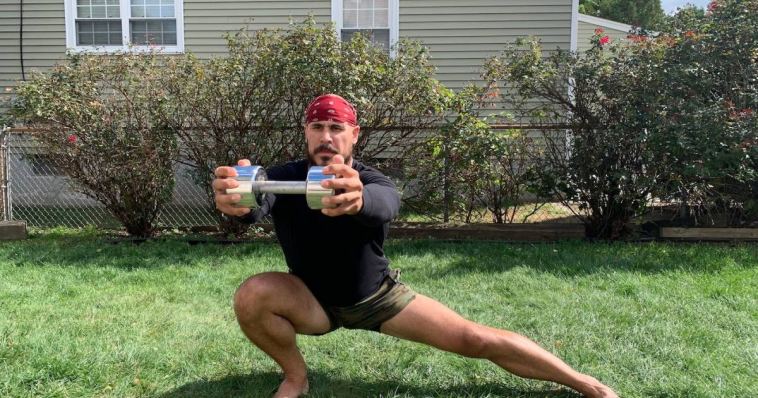- Like
- SHARE
- Digg
- Del
- Tumblr
- VKontakte
- Flattr
- Buffer
- Love This
- Save
- Odnoklassniki
- Meneame
- Blogger
- Amazon
- Yahoo Mail
- Gmail
- AOL
- Newsvine
- HackerNews
- Evernote
- MySpace
- Mail.ru
- Viadeo
- Line
- Comments
- Yummly
- SMS
- Viber
- Telegram
- JOIN
- Skype
- Facebook Messenger
- Kakao
- LiveJournal
- Yammer
- Edgar
- Fintel
- Mix
- Instapaper
- Copy Link
So, when we start training heavy two-legged or bilateral movements like squats and deadlifts, it would make sense that we’d begin to develop a bias to push harder, shift toward, or favor our dominant side.
It’s part of the deal in being a human being, and no measure of one-side focused remedial exercises or drills will make us perfectly balanced.
There’s no point in obsessing over this because we’re, by nature, imbalanced.
We should always concentrate on the foundations that are beyond every movement and exercise. If you’re interested in learning what these foundation principles are, check out this new course I’m offering.
When the Imbalance Is Too Much
Sometimes though, the gap between the sides and segments can grow a little too large. When that happens, we need smart exercises that train all variables to help move the meter back toward your baseline, a reasonable asymmetry.
The cossack squat demands you move in positions that can be difficult at first to do, but the movement itself is simple and straightforward.
It can be done anywhere with bodyweight or loaded in different ways with whatever kind of weights are available to you.
Why The Cossack Squat?
Any single-leg exercise can improve stability and physical awareness. What makes the cossack squat valuable is that you have the light support of your trail leg.
This support enables you to focus on controlled moving through the entire range of motion available to you while building more mobility and strength at the end of your range.
As you drop down, you’re moving at the limit of your hip and ankle range of motion. Just look at the picture above. I’m doing as deep of a squat as I possibly can on one side of my body.
We all tend to emphasize linear movements where we move straight up and down. If you want a big squat and deadlift, there’s nothing wrong with that. But you need to make sure that you’re moving in different directions and patterns of movement at least some of the time.
The cossack squat is an exercise you can add to the end of your workouts that gets you moving in a different plane.
It would be best if you moved through these different patterns to prevent pattern overload (injuries to your soft tissues from moving in only one pattern or limiting the free range of motion for too long).
It would help if you moved in these different positions to keep all of the connective tissue in the body healthy.
The longer we’ve been training, the more we may need this.
The older we get, the more we need to move in every possible way.
And the more we sit for work, the more we should move in every movement pattern possible.
Use Every Pattern of Movement
https://www.youtube-nocookie.com/embed/88vZBfRYo3g
- Place your feet one to two-foot lengths outside of shoulder-width apart. You may have to adjust your feet wider. Play around with your stance to figure out what’s comfortable and strong.
- Ground the foot on the side you’re going to squat toward first. Push your big toe firmly into the ground and create pressure against the ground outside of your foot, directly below the outer edge of the ankle.
- You can turn your toes out at first but eventually work toward keeping them pointed straight as it will challenge your mobility and stability at new levels.
- Use your other foot on the opposite side to help you and push you into the squat.
- Lower yourself into the squat without letting your heels or any part of your feet lose contact with the floor. Some variations allow your toes on your trail leg to lift and rotate up but keeping them down is better to challenge your adductors mobility.
- Push off the foot you’ve squatted toward to push your hips up and back toward the middle.
- Without pausing, lower yourself to the other side, keeping the same points of contact and ideas in mind.
Weighted Cossack Squat
Usually, to add weight to this exercise, you’d hold the weight out in front of you to use as a counterbalance to keep you upright, or you’d hold it close to your body.
If you want to change it up, try holding a weight behind your head.
Holding a weight behind your head tests your dexterity to stay upright.
You’ll train the upper back’s strength and mobility, and your trunk will work even harder to keep posture and stabilize you. Win, win, and win.
Watch Your Limit
The point of this exercise isn’t to bend and fold yourself into a position that you can’t yet reach. It’s to find the edge of your mobility and stability in this motion and challenge it slowly, without losing posture and rigidity or compensating in some way.
If you consistently practice it, you’ll reach this bottom position, but your adductors, knees, and ankles won’t like you very much if you try to force it too soon. And if you’ve had recent ACL knee surgery, take it slow, even if you feel 100%. Slow and steady wins the race here..
Ready For More Difficulty?
There are a few different ways to load this exercise to make it more challenging. Holding a weight behind your head, which I already described, is one. Keeping weight overhead with arms extended is another.
But there’s something else you can do to test your mobility and stability that doesn’t necessarily require any weight.
Choose the side you’re squatting toward and place a small plate or similar flat object under that foot. Do your chosen number of reps and then switch sides.
Just by elevating your foot a few inches, you’ll be fighting to maintain position while you lower into a deeper position.






